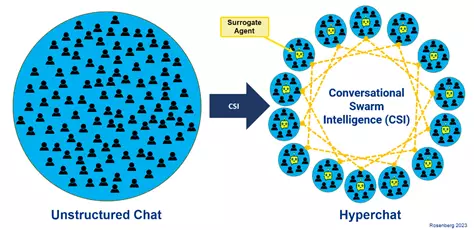Imagine a scenario where a sprawling team, potentially as large as 200 members, engages in a dynamic, fluid conversation that allows them to brainstorm, share insights, and arrive at well-informed decisions instantaneously. This dream has long been stifled by the limitations of traditional communication tools that fail to facilitate meaningful discussions in large groups. However, emerging technology—specifically conversational swarm intelligence, or “hyperchat”—is pitting the scale of teams against the effectiveness of their collaboration. By leveraging artificial intelligence, hyperchat aims to enhance the way groups communicate, providing a structure in which collective intelligence can thrive unhindered.
Understanding the Challenges of Group Dynamics
To appreciate the revolutionary potential of hyperchat, one must first understand the pitfalls of conventional group discussions. Research consistently reveals that optimum group size for effective conversations typically ranges between four to seven participants. Larger groups tend to devolve into chaotic exchanges where airtime dwindles and meaningful contributions slip through the cracks, resulting in a disorganized cacophony rather than a structured dialogue. Thus, the challenge remains: how can large organizations utilize the wealth of knowledge and ideas from many employees without succumbing to the inefficiencies of size?
Enter hyperchat technology, which cleverly navigates these challenges by dividing larger groups into smaller, manageable subgroups. Each subgroup is then equipped with an AI-driven “conversational surrogate.” This surrogate actively listens and condenses the discourse into digestible insights, which can be shared across other groups, creating a seamless conversation tapestry. The aim is clear: to synthesize the brilliance of collective thought without succumbing to the chaos that typically accompanies large teams.
The Groundbreaking Experiments
To validate this groundbreaking system, a group of 50 sports enthusiasts was tasked with crafting a March Madness bracket using hyperchat. This initiative, spearheaded by Unanimous AI, served as both a practical test of the technology and a social experiment in collaborative intelligence. Contrary to what one might expect, the resultant bracket didn’t merely meet expectations—it far exceeded them, successfully placing in the 99th percentile of all brackets submitted to ESPN.
These eye-opening results aren’t just anecdotal; they are supported by a burgeoning body of empirical research. Studies have indicated that groups utilizing hyperchat achieved an effective IQ score significantly above their individual performances, showcasing that collective discussion can elevate understanding and decision-making beyond what isolated work typically yields. For example, one 2024 study indicated that participants who engaged in hyperchat scored an effective IQ of 128, cementing the notion that dialogue-enabled platforms can unlock the latent genius within large groups.
Empowering Teams through Enhanced Collaboration
The implications of such technology extend well beyond mere sporting events. Hyperchat not only streamlines communication among numerous participants, but it also infuses traditional teamwork with an invigorating sense of ownership and engagement. Participants reported higher levels of satisfaction with the decision-making process when collaborating through hyperchat. They felt more empowered and expressed that they were more likely to buy into the solutions produced.
Moreover, hyperchat has demonstrated a distinct advantage when juxtaposed against standard chat tools. Participants reported more positive sentiments and a stronger sense of productivity. Here, the critical role of added contributors—AI agents designed to provide real-time factual input—becomes even more crucial. These “contributor agents” seamlessly interact with human participants, equipping teams with timely information and enhancing the quality of discussions. This fusion of human intuition with AI analysis leads to a concept being labeled as “hybrid collective superintelligence.”
The Future of Collaborative Intelligence
As hyperchat technology strides forward, the opportunities for its application seem virtually limitless. Particularly in corporate environments, where many Fortune 1000 companies employ thousands of individuals, hyperchat could resolve the long-standing complications inherent in large-scale collaboration, all while keeping the ultimate decision-making power firmly in human hands. By enabling real-time conversations among teams reflective of vast organizational diversity, it may be the key to unlocking the true potential of collective human intelligence in the workplace.
Indeed, given the speed with which hyperchat is evolving, we stand at the precipice of a transformative era—one where the integration of AI enriches human interaction in unprecedented ways. The March Madness experiment may simply be a precursor to a world where intelligent dialogue becomes the standard for organizations seeking to tap into the succinct brilliance of their collective brainpower, and where every voice—no matter how small—holds the potential to shape a larger narrative.


Leave a Reply